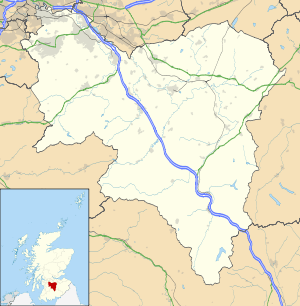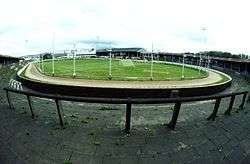Shawfield Stadium
|
View from the terracing | |
 Shawfield Stadium Location in South Lanarkshire | |
| Location |
Rutherglen Road Rutherglen, Glasgow G73 1SZ, Scotland |
|---|---|
| Coordinates | 55°50′18″N 4°13′44″W / 55.83833°N 4.22889°W |
| Surface | Grass |
| Opened | 1898 |
| Tenants | |
|
Clyde F.C. (1898–1986) Glasgow Tigers (1988-1995, 1997-1998) Scottish Monarchs (1996) | |
Shawfield Stadium is a greyhound racing venue in the Shawfield district of the town of Rutherglen, South Lanarkshire, Scotland, located close to the boundary with Glasgow.[1]
It has also previously been a regular venue for football and speedway, as home to Clyde F.C. and the Glasgow Tigers respectively. Other sports including boxing and athletics have also been staged there.
From 1997, the stadium has been the only Greyhound Board of Great Britain (GBGB) greyhound track still in use in Scotland . It has hosted the Scottish Greyhound Derby since 1989, as it did from 1970 to 1985.
Greyhound Racing
Competitions
Opening
John Bilsland (sole owner of Stanley in Liverpool) helped instigate the plans to open Shawfield in his home town and brought the greyhounds to the home of Clyde F.C.. The football club had been based at the stadium since it opened in 1898 but were experiencing financial difficulties by 1930 resulting in the need to find new income streams. The club had tried previously to allow greyhound racing to take place at Shawfield but the Football league was opposed to the idea. Finally an agreement was reached with the chairman John McMahon and the Shawfield Greyhound Racing Company Ltd (SGRC) was born. [2] The track opened on 14 November 1932 in the North Rutherglen area of Glasgow and was a big galloping circuit of 473 yards with 125 yard straights with well banked bends and it became a very popular venue. When Shawfield opened for racing the city of Glasgow already hosted four other National Greyhound Racing Society affiliated tracks in Albion, Carntyne, White City and Firhill. In addition there were the independent tracks of Clydeholm, Coatbridge and Mount Vernon which totalled eight tracks in Glasgow at the time. [3]
The first recorded winner was 'Swordmanship' receiving six yards in a 303-yard handicap race, the time was 18.45 sec. The SGRC bought the stadium from Clyde FC in 1935. [4]
History
After the war had finished the SGRC was valued at £4,000 in 1946 by the taxman but the figure proposed by the owners was only £600 resulting in a dispute. As with most tracks at the time Glasgow experienced a profitable spell during the early fifties but both Albion and Firhill were closed to greyhound racing by the end of the decade. White City had shut by 1962 and in 1968 Carntyne was the latest track to close their doors which had a knock on effect for Shawfield. With the Scottish Greyhound Derby left without a home there were only two tracks big enough to host the event, Powderhall Stadium or Shawfield. The copyright of the Scottish Derby was held by the Greyhound Racing Association (GRA) and they decided that Shawfield could host the 1970 Scottish Derby. Jim Layton was Racing Manager at the time and one year later the track also received another prestigious former Carntyne competition called the St Mungo Cup. [5]
In 1975 a devastating fire at the track resulted in the loss of the majority of facilities for the public. To combat this an investment program that included a state of the art totalisator system, ray timing and photo finish equipment was planned and this period also saw the GRA arrive on the scene as they acquired the track under their the GRA Property Trust. The track made the National Intertrack final in 1976. [6]
In 1983 the track came on the open market, Clyde FC were given notice to leave in 1986 and the stadium shut down on 25 October 1986. Supporters of the track lobbied to save the track and with the help of Billy McAllister, a former bookie, Racing Manager and racing reporter at the track, the Shawfield Action Group was formed. An 8,000 strong petition helped stave planning permission and there was some good news when a business consortium bought the track instead of the expected developers. On 11 June 1987 the track re-opened under the Shawfield Greyhound Racing and Leisure Company Ltd. [7] In 1988 the GRA lost their rights to the Scottish Derby following the sale of Powderhall and the Scottish Derby returned to its Glasgow roots. The management which included Robert Lithgow (Racing Manager), had already re-introduced the St Mungo Cup and William King Cup. A £100,000 facelift completed the takeover.
The large tote board which dominated the south end of the track was demolished in 2004 and the track today is the only remaining licensed track in Scotland. [8]
Track records
| Distance | Greyhound | Time | Date |
|---|---|---|---|
| 300m | Ravage Again | 17.35 | 07.04.1990 |
| 450m | Fair Hill Boy | 26.85 | 27.10.1989 |
| 480m | Droopys Buick | 28.63 | 02.04.2016 |
| 500m | Droopys Sandy | 29.39 | 21.05.1994 |
| 670m | Crack of the Ash | 40.50 | 11.09.1993 |
| 725m | Woopsy | 45.91 | 1987 |
| 730m | Decoy Princess | 45.09 | 20.02.1988 |
| 882m | Rosemoor Flower | 56.55 | 13.04.2002 |
| 932m | Silken Dancer | 59.35 | 02.09.1993 |
| 500mH | Face The Mutt | 31.07 | 25.05.1982 |
| 510mH | Lovely Pud | 31.63 | 09.07.1984 |
Football
Clyde F.C. took over the site, previously a trotting track, in 1898.[10] The club earned additional revenue from using Shawfield for boxing and Track and field; greyhound racing was introduced in 1932.[10] Clyde's financial difficulties led to the sale of Shawfield to the Shawfield Greyhound Racing Company Ltd in 1935, but the club continued to play there as tenants.[10] During the Second World War, Clyde almost had to leave Shawfield because the owners demanded the use of the stadium on Saturday afternoons.[11][12] Eventually a compromise was reached where the stadium would be used for dog racing on alternate Saturday afternoons, allowing Clyde to play their home fixtures.[12]
After the World War II, Clyde and the other Glasgow area clubs struggled to compete with the dominant Old Firm.[13] In addition to this, the heavily populated tenements surrounding Shawfield had been cleared in the 1960s, reducing Clyde's support base.[10] The club proposed to move to the new town of East Kilbride in 1966.[10] Four years later, Clyde attempted to take over Hamilton Academical.[14] This collapsed when four of the Hamilton directors secured a lease on Douglas Park.[14] Clyde continued to play at Shawfield until 1986, when the GRA's redevelopment plans led to Clyde's eviction.[10] Despite the collapse of the redevelopment plans, Clyde did not return to the ground, although this was proposed in 1988.[10] Clyde eventually accepted an offer from Cumbernauld to move to what became Broadwood Stadium.[10]

Speedway
The Glasgow Tigers, returning to their home city in 1988 after a year's exile in Workington, became the new tenants after Clyde FC. The Tigers raced there for a decade, apart from the 1996 season when they were temporarily in abeyance and replaced by the ill-fated Scottish Monarchs who had a team but no track due to the closure of Powderhall. When the venue opened, the racing could be viewed from two straights and the third and fourth bends but over the years the viewing area was reduced to a small part of the stadium in front of the stand. They departed to Ashfield Stadium ahead of the 1999 season.
Location anomalies
- Historically, the boundary between the City of Glasgow and the county of Lanarkshire passed right through Shawfield. During World War II, when the gathering of crowds in areas deemed "unsafe" were severely restricted, this meant Shawfield was allowed to accommodate 20,000 spectators, whereas Celtic Park, less than a mile away but wholly located in Glasgow was permitted only 10,000 people in a much larger venue.
- In the 1966–67 season, Clyde's third-placed finish in the Scottish League should have earned them a place in the Inter-Cities Fairs Cup, however a one club per city rule applied to the competition, and second placed Rangers had precedence to represent Glasgow. Clyde attempted to argue that Shawfield's location actually meant they were from the separate town of Rutherglen, however the organisers of the tournament cited Clyde's membership of the Glasgow Football Association and participation in the Glasgow Cup.
- Local government reorganisation in 1975 meant that Rutherglen, and Shawfield with it, was now incorporated entirely into an expanded Glasgow district. Further changes in 1996 created the new unitary authority area of South Lanarkshire, with Shawfield now lying entirely within this area and no longer even partially in Glasgow.
References
- ↑ "Track Search". Greyhound Board of Great Britain. Retrieved 24 December 2011.
- ↑ Genders, Roy (1990). NGRC book of Greyhound Racing, page 29. Pelham Books Ltd. ISBN 0-7207-1804-X.
- ↑ Barnes, Julia (1988). Daily Mirror Greyhound Fact File, page 132. Ringpress Books. ISBN 0-948955-15-5.
- ↑ Barnes, Julia (1988). Daily Mirror Greyhound Fact File, page 132. Ringpress Books. ISBN 0-948955-15-5.
- ↑ Genders, Roy (1981). The Encyclopedia of Greyhound Racing, pages 70-71. Pelham Books Ltd. ISBN 07207-1106-1.
- ↑ Genders, Roy (1990). NGRC book of Greyhound Racing, page 29. Pelham Books Ltd. ISBN 0-7207-1804-X.
- ↑ Barnes, Julia (1988). Daily Mirror Greyhound Fact File, page 132. Ringpress Books. ISBN 0-948955-15-5.
- ↑ Hobbs, Jonathan (2007). Greyhound Annual 2008, page 204. Raceform. ISBN 978-1-905153-53-4.
- ↑ "Track records". Greyhound Data.
- 1 2 3 4 5 6 7 8 Inglis 1996, p. 436
- ↑ (Bob Crampsey 1990, p. 97)
- 1 2 (Bob Crampsey 1990, p. 115)
- ↑ (Bob Crampsey 1990, p. 182)
- 1 2 (Bob Crampsey 1990, p. 183)
- Sources
- Bob Crampsey (1990). The First 100 Years. Scottish Football League. ISBN 0-9516433-0-4.
- Inglis, Simon (1996). Football Grounds of Britain. Collins Willow. ISBN 0-00-218426-5.
External links
- Official website
- Stadium and track info from dog-track.co.uk
- Photos of racing at Shawfield in 1955, from the Mitchell Library archive
